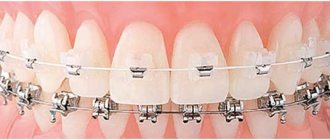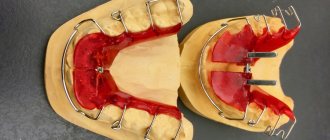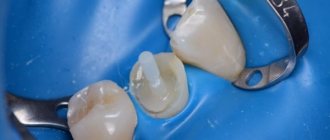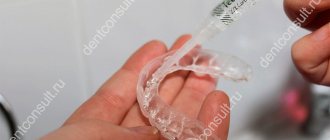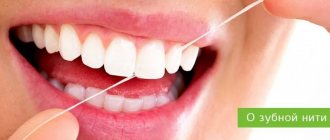Braces are non-removable orthodontic structures that remain in the oral cavity throughout the treatment process.
The duration of correction ranges from several months to two years. Braces cause some discomfort at the beginning of treatment, but later their presence becomes almost unnoticeable. However, every patient thinks about the day when it is time to remove them.
Thanks to modern technologies, it is possible to correct malocclusion or other dental anomalies at almost any age.
When will it be possible to remove braces from my teeth?
To change the position of the teeth in a row, you will have to wear braces for quite a long time - at least several months, but positive changes will appear much faster. By assessing the results of treatment with braces, the orthodontist will be able to indicate to you the expected completion date of the bite correction course.
The timing of treatment will depend to a certain extent on you: if you want to remove braces from your teeth as quickly as possible and at the same time acquire a beautiful smile with straight teeth, you must strictly follow all the orthodontist’s recommendations and not miss visits to the clinic to monitor the results of the correction.
Calculate the cost of treatment by taking a short test in 20 seconds!
Do not delay your treatment, because in this matter time plays against us.
Cost of dental braces removal procedure
The average price for removing braces in Russia is 10,000 rubles ($154 at the time of writing). In general, prices vary depending on the clinic and city. The lowest price we were able to find was 3,000 rubles for one jaw (about $46), the maximum was five times more. Unfortunately, the pricing policy does not always reflect the quality of the services provided.
Cost of removing braces
In Ukraine, such services are much cheaper. For example, making a retainer will cost you 700 hryvnia. That's about $27. In St. Petersburg, the production of a retention mouth guard will cost 7000-8000 (108-123 usd). The cost of a mouth guard also depends on the material. For example, if it contains a reinforcing metal arc, such a product will be more expensive than an analogue made from a biopolymer without metal parts.
Average prices for orthodontic treatment:
| Name | Price |
| Consultation | 1140 rubles |
| Casts | 1140 rubles |
| Braces (1 dental arch) metal | 34200 rubles |
| Braces (1 dental arch) ceramic | 64600 rubles |
| Braces (1 dental arch) lingual | 88160 rubles |
| Arc installation | 3420 rubles |
| Re-bonding the bracket | 1216 rubles |
| Removing the bracket | 2660 rubles |
| Teeth whitening (using aligners) | 11400 rubles |
Removing braces: how to remove the orthodontic structure
Where can braces be removed and how will the procedure take place? These questions concern many people undergoing orthodontic treatment or just preparing to wear braces. Many people think that it is painful or unpleasant, or mistakenly assume that they can remove braces themselves, at home. In fact, it is impossible to remove braces without visiting an orthodontist’s office. This is a simple and non-painful procedure, so there is no need to be afraid of it. To remove braces from your teeth, the doctor will not have to perform any complicated actions; the removal process will go through quite quickly. Lingual braces are removed within an hour, conventional vestibular braces are removed even faster - in 20-30 minutes.
How does the process work? We will describe to you the procedure for removing braces from your teeth in detail. So, to remove your braces, you will go to the orthodontist, and the doctor will do the following:
- Install a retractor in the oral cavity, which will protect the soft tissues of the mouth and mucous membranes during removal of braces;
- Remove the braces system. To remove the structure, the orthodontist will first remove the arches and ligatures, and then the braces themselves.
But simply removing the braces is not enough - after removing the orthodontic structure, be sure to remove any remaining adhesive from the dental surfaces, grind and polish the tooth enamel, and then treat it with a special remineralizing compound.
When are braces removed?
After installation of the system, the patient visits the orthodontist at least once a month. The doctor adjusts the effects of braces and monitors the effectiveness of therapy. When the planned result is achieved and the risk of relapse is unlikely, the orthodontist will notify the patient that the correction phase has ended. During the next visit, he assigns the patient a day to remove braces, explains the stages of preparation and describes the procedure itself.
The duration of the dental treatment process is influenced by the following factors:
- Complexity of the clinical case. If the problem is only a violation of the location of individual units of the dentition, then it can be corrected in 0.5-1 year. In case of multiple anomalies and pathologies, the duration of the correction course increases.
- Age. The peculiarities of the structure and maturation of the dentofacial apparatus in children make it possible to achieve correction of occlusion and the location of teeth in the jaw with less effort and twice as fast as in adults, who have inertia in plastic processes.
- Type of orthodontic structure. Vestibular metal braces exert intense, uniform translational pressure on areas of the skeletal system of the jaw, which leads to a pronounced result and a reduction in the correction period. You need to wear classic braces 1.5-2 times less than lingual and ceramic braces.
- Accuracy of installation and adherence to therapy rules. The specialist selects the type of structure, calculates mechanical forces, elasticity of the arches and develops a correction scheme, which affects the effectiveness and duration of treatment. The course also depends on the patient’s compliance with the doctor’s recommendations and the timing of visits to the dental clinic, maintaining oral hygiene, and proper care of the device.
- Planned effect. The duration of the correction course is influenced by the result that the patient expects to receive. He can be focused only on the aesthetic appearance of the teeth, especially if other deviations do not cause him any inconvenience, and refuse to continue wearing the orthodontic structure after achieving the desired result.
Taking into account the listed factors, the period of correction using braces can range from 1.5-2 to 3 years. It is impossible for a non-specialist to visually determine that the treatment is completed and it is time to remove the orthodontic structure, so you should trust the doctor’s decision and complete the correction course.
No special preparation is required for the removal of orthodontic structures. Braces can be removed in one session or several - it depends on the complexity of removal, the individual sensitivity of the patient, and the duration of the procedure.
Does it hurt to remove braces from your teeth?
One of the common questions from braces patients is: does it hurt to remove braces from your teeth? No, this procedure is painless and can be performed without the use of local anesthesia. Of course, some discomfort during removal of braces is not excluded, but it can be withstood without an anesthetic injection.
If you have a low pain threshold and high tooth sensitivity, warn your doctor about this. Then, before removing the braces, the doctor uses local anesthesia so that the removal procedure takes place without pain or discomfort.
Painfulness of the procedure
The main concern of many patients is the pain that occurs during the process of removing the retainers. But in fact, when removing the brackets, the dentist does not interact with either the enamel or gum tissue, which eliminates any pain. The only chance to experience physical discomfort is to constantly twitch and fidget in the doctor’s chair, sooner or later forcing him to touch open areas with forceps.
Polishing tooth enamel is also a painless procedure. All that is required of the patient is to remain persevering and calmly endure the prescribed activities.
Can I remove braces myself?
One important thing you need to remember is that it is impossible to remove braces safely at home. In order to properly remove braces without damaging tooth enamel and soft tissues of the mouth, you need to have special knowledge, skills, and have dental instruments at your disposal. There are articles on the Internet that tell you how to remove braces at home, but do not follow the instructions given in them: this will not lead to anything good, you can damage your teeth and gums and provoke the development of an inflammatory process.
In addition, removing braces to complete orthodontic treatment is not enough. After the braces are removed, special structures are placed on the teeth - retainers, which secure the result of the bite correction and prevent the teeth from moving apart again. Retainers cannot be bought on the Internet or in a store, and what’s more, they cannot be installed correctly and securely on your own.
It is also impossible to remove the braces yourself because after removing the structure, the glue that was used to fix the plates remains on the teeth. To remove it, the surfaces of the teeth need to be sanded and polished. Remineralization of tooth enamel is also required to restore its structure after wearing braces for a long time.
Is it possible to remove braces if the system breaks down?
Braces are durable structures that can withstand heavy loads well. But if the patient does not follow the doctor’s recommendations, the braces may come off. Even under these circumstances, you should not attempt to remove braces yourself! Such attempts may cause you to damage the entire system!
Therefore, there is no need to bother removing braces; your task in such a situation is to get an appointment with an orthodontist as quickly as possible, since the absence of even one element in the system disrupts the balance of the structure and significantly reduces the effectiveness of braces. If you cannot get to the orthodontist in the next day or two, visit the pharmacy, buy medical wax and use it to secure the bracket on the surface of the tooth from which it fell off.
What to do if the bracket comes off or the arch in the bracket system breaks?
Every brace wearer has at least once encountered the breakdown of elements of the brace system. You need to take this calmly, but you should return everything to its place as quickly as possible. A broken brace system not only does not correct your bite, it can cause serious harm.
So, in case of any force majeure with your braces system, call your orthodontist and make an appointment for the next few days.
What you can do yourself in various cases of brace system failure:
1. If the bracket comes off.
If the lock has only come off a little and has not completely fallen off the tooth, cover it together with the arch with a piece of orthodontic wax.
If the bracket has come off completely and is “hanging” on the arch, try using tweezers to remove the ligature or open the bracket cover to remove the lock from the orthodontic arch. Don’t forget to bring it to the orthodontist later - perhaps he will not change the lock, but will glue the old one in its place.
2. The orthodontic arch has jumped out of the bracket slot.
You can try to bring it back yourself using eyebrow tweezers. It is convenient to close the cover of a self-ligating bracket with a pencil with an elastic band at the end. If it doesn’t work out, it’s okay, but don’t put off visiting the orthodontist, because... in this situation, one tooth “fell out” of the treatment program, and this is bad.
3. When the orthodontic arch leaves the groove of the last bracket, it can injure the buccal mucosa. Try to carefully insert it back. If this does not work, then trim the free piece with nail clippers. Be careful not to swallow what you cut off! Cover the sharp end of the archwire with orthodontic wax or a cotton ball. This way you won't get hurt while getting to the orthodontist.
What happens to my teeth after braces are removed?
One of the reasons why braces can only be removed in a dental clinic is the poor condition of the teeth. After removing braces, glue remains on the surface of the teeth; there may be noticeable cracks and white spots formed due to insufficient nutrition of the dental tissues while wearing braces.
It is important to understand that wearing braces negatively affects only aesthetics, but not the health of your teeth. Aesthetic defects will be easy to eliminate: to do this, it is enough to remove the braces, grind and polish the tooth enamel, and conduct a course of its remineralization. Usually these measures are quite enough to completely restore the aesthetics of the appearance of teeth.
But if you want to get the perfect Hollywood smile, then after removing braces, you can put veneers on your teeth, carry out the procedure for whitening tooth enamel, and resort to any other artistic restoration methods.
How does it depend on the species?
The duration and quality of the removal procedure directly depends on the type of bracket system. The easiest and fastest way to remove metal devices .
Ceramic and sapphire models require a little more time , as they are more tightly attached to the tooth surface than the classic metal version.
To prevent fragile clasps from completely crumbling, the orthodontist constantly needs to monitor the applied forces, which increases the time it takes to remove the system.
In addition, no matter how hard the orthodontist tries, many fragments from aesthetic models will still remain on the surface of the teeth. This will require lengthy and thorough surface sanding. In contrast, the metal system is removed with virtually no splinters .
The duration of the procedure is also affected by the type of braces. Removing lingual braces will be longer and more difficult than vestibular braces due to the inconvenience of manipulation.
If we consider the vestibular systems separately, then non-ligature options are faster to remove, since they are characterized by the ease of removing the arch from the locking mechanism.
What procedures will be performed after braces are removed?
Removing braces does not mean ending the course of orthodontic treatment. First of all, the doctor will restore the aesthetic appearance of the teeth.
For this purpose, the following procedures are carried out:
1. Hygienic cleaning. This procedure allows you to remove residual adhesive, tartar and plaque from the surfaces of your teeth. Deposits actively accumulate under braces during the treatment period, and in order to keep teeth healthy, they must be removed.
2. Remineralization of tooth enamel after removal of braces. It is carried out by treating the surfaces of teeth with fluoride and calcium preparations, which saturate the weakened enamel with nutrients and restore its healthy structure.
We wrote above that after removing braces, you can do whitening to get a perfect smile. However, we advise you to remove your braces and wait about a month to whiten your teeth. During this time, the enamel and dental tissues will be sufficiently restored. If you whiten your teeth immediately after removing braces, there is a high risk of tooth hypersensitivity and even pain.
Why do you need to remove braces and put retainers on your teeth?
Many patients are upset by the fact that it is not enough to remove the braces and complete the course of bite correction: after removing the braces, they will need to wear special structures on the teeth - retainers. Wearing retainers helps to consolidate the achieved positive result in correcting the bite, because if you remove the braces and do not put on the retainers - without the pressure that the brace system puts on the teeth, they will tend to return to their previous position.
Retainers will hold your teeth in the correct position and prevent them from moving. After your braces are removed, your orthodontist may suggest that you install removable or permanent retainers.
Fixed retainers
They are the thinnest wire that is glued to the inner surface of the teeth from the tongue side. Filling materials are used to fix the wire; it will be absolutely invisible to prying eyes and will not cause any discomfort when worn.
Removable retainers
When you come to the orthodontist to remove your braces, the specialist may offer you removable retainers.
These structures can be in the form of thin plates or silicone mouth guards and are worn over the teeth while you sleep. After removing braces, retention mouthguards are made according to an individual impression and their use requires a certain amount of discipline from the patient - if you don’t put the mouthguard on every day and forget about it, you can nullify all the positive results achieved from wearing braces. How long will you have to wear retainers after your braces are removed? Let's answer honestly - the retention period after removing braces is usually quite long; its duration can exceed the duration of the correction course by 2-3 times. And besides, some patients will have to wear retainers after removing braces for the rest of their lives to maintain a beautiful smile with straight teeth.
Using retainers
So, the braces are off - what next? And then you need to consolidate the result. After all, no matter how long you wear braces on your teeth, you need to use retainers. They come in two types - removable and non-removable.
- Braces for children
Removable and non-removable retainers
A permanent retainer is a special arch that is installed, this time, on the inner surface of your teeth. Most often, fangs are chosen to fix it. If you choose a simpler option, the doctor makes an impression, on the basis of which mouth guards are made from plastic material. They, unlike braces, are removable. But this is the main catch. Many people, either accidentally or intentionally, do not wear a mouthguard. This leads to negative consequences.
Retention mouth guard
Aligners (clear aligners) are worn 22 hours a day. They can only be removed when eating and brushing your teeth. That is, you will have to wear them to work, school, and even on a date. Otherwise you will have to suffer much longer.
The choice between a removable and a permanent retainer is made by the orthodontist. If the correction was performed on both jaws, then a combined option can be used. That is, an aligner is placed on the jaw with minimal defects, and an internal brace is placed on the other jaw. The installation of retainers itself is a simple, quick and painless procedure. As for efficiency, it is still better to install an arc. This way you will know for sure that you will achieve results. Because statistics show that a large percentage of people forget to wear mouth guards.
Retainers after braces
Video - Types of Retainers and what they are needed for
Will my teeth hurt after my braces are removed?
You need to prepare for the fact that you will experience physical discomfort for some time after your braces are removed. It occurs because the teeth, after removing braces, tend to return to their previous position, and retainers prevent this.
High tooth sensitivity may also occur, explained by the fact that while wearing braces, tooth enamel becomes thinner and weakens. Therefore, pain may occur when drinking hot/cold drinks and food.
The orthodontist must warn you about such side effects before removing braces. In addition, the specialist should advise you in detail on the proper care of your teeth and oral cavity after removing braces and installing retainers.
How braces are removed at DDClinic
Removal of a classic ligature apparatus begins with the removal of rings and locks, continues by removing the arches and detaching the braces from the teeth, and ends with cleansing the tooth enamel from the remnants of the fixing material. The whole procedure takes a few minutes.
In the case of a non-ligature system, the lock on each bracket is first opened, and then the same manipulations are performed as when removing the ligature system.
Lingual braces are attached to the inside of the teeth, so they take a little longer to remove - approximately 30 minutes.
How to properly care for your teeth and oral cavity after removing braces?
After removing braces, weakened tooth enamel and tooth tissue need time to fully recover. This is why it is so important to ensure proper oral hygiene. It is imperative to undergo professional teeth cleaning and teeth remineralization procedures - they are performed in a clinic and may require several visits to a specialist’s office.
At home, after removing braces, you must regularly and thoroughly brush your teeth, use an irrigator or dental floss to remove plaque from the interdental spaces, and use balms and rinses to prevent gum inflammation. In all these procedures it is necessary to use gels and pastes, which the orthodontist will recommend to you. Usually, pastes with a high fluoride content are prescribed, as well as special remineralizing gels, which are used to treat the teeth after brushing.
Calculate the cost of treatment by taking a short test in 20 seconds!
Do not delay your treatment, because in this matter time plays against us.
Is it possible to remove braces from teeth ahead of schedule?
It is possible to remove braces ahead of schedule only if the process of correcting the bite went faster than initially predicted. But such cases are very rare. More often, the need to remove braces ahead of schedule arises under the following circumstances:
- Conservative orthodontic treatment does not give a positive result. In this case, it is advisable to remove the braces and correct the bite with surgery;
- Braces will have to be removed if the system breaks down or if the patient has an allergic reaction to it.
Other reasons (including special occasions, significant events) are not considered valid for removing braces. Of course, if you insist, the doctor will remove the braces from your teeth and put them on after some time. But at the same time, you will have to install a new structure, and the treatment time may increase significantly. In addition, early removal of braces can have a negative impact on the functioning of the maxillofacial joint.
If you know that after some time a significant event is planned in your life, you lead a public lifestyle - it is best to initially make a choice in favor of aesthetic and invisible types of braces on the teeth - ceramic, sapphire, lingual brace systems. Then the braces will not have to be removed, and you will be able to complete the course of treatment without unnecessary expenses and visits to the clinic.
How to get used to the braces system?
Any braces are a foreign body in the oral cavity. And in the first couple of weeks after their installation, the body will be uncomfortable with them. Then addiction will set in, and the braces system will no longer cause inconvenience.
During the habituation period, you may experience:
- increased salivation,
- impaired speech clarity,
- The braces system can rub the mucous membrane.
To reduce these negative effects to a minimum and quickly get used to braces, we recommend:
- Rinse your mouth with astringent solutions - decoctions of oak bark, shepherd's purse, drink tea with viburnum, water with lemon - this will help reduce saliva production.
- Practice pronunciation by speaking tongue twisters or simply reading aloud. This way your speech apparatus will quickly get used to the new working conditions.
- Use orthodontic wax to cover interfering clasps. Your orthodontist will give out the wax immediately after fixation. If the braces are rubbed and inflammation appears on the mucous membrane, use a healing ointment. In this case, Solcoseryl will work well.
- Always have a travel hygiene kit with you so you can brush your teeth immediately after eating.



